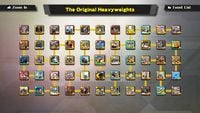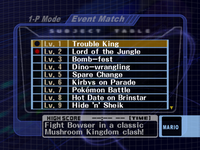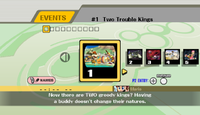Event match: Difference between revisions
(→In Super Smash Bros. Melee: even more shorter this way) |
m (→In Super Smash Bros. Ultimate: added the word traditional) |
||
| Line 78: | Line 78: | ||
==In ''[[Super Smash Bros. Ultimate]]''== | ==In ''[[Super Smash Bros. Ultimate]]''== | ||
Traditional event matches are absent from ''Ultimate''. However, [[Spirits]] Matches (and stages from the [[World of Light]]) feature similar fights with unique conditions. In addition, fights in various fighters' [[Classic Mode (SSBU)|Classic Mode]] routes have unique conditions similar to those of event matches. | |||
==See also== | ==See also== | ||
Revision as of 19:09, November 24, 2020
- "Event" redirects here. For the events that occur randomly in Smash Run, see Smash Run. For the weekly events in Super Smash Bros. Ultimate, see List of Spirit Board events and Online Tourney#List of Event Tourneys.
Event match (イベント戦, Event Battle) is a single-player mode found in Super Smash Bros. Melee, Super Smash Bros. Brawl, and Super Smash Bros. for Wii U. Event matches are challenges that place the player into specific scenarios with special conditions and a certain objective to meet, many of which pay homage to the characters and their history. Each game records the completion and "score" of each event match.
In Super Smash Bros. Melee
Event matches were introduced in Super Smash Bros. Melee, as part of the game's single-player mode. Only 10 are initially available to the player, with the rest appearing as the player fulfills a number of other objectives in the game. There are a total of fifty-one event matches in Melee, and beating all of them unlocks the stage Final Destination.
A majority of Melee's event matches allow the player to select their character, although several of them require the use of an assigned character. Of note is that, with the exception of Pikachu, all characters in the Original 12 from Smash 64 have their own dedicated event match.
Unique to Melee's event matches, compared to its other single-player modes, is that some matches require players and opponents to use an alternate costume.
Also of note is that no recovery items (like Food, Maxim Tomatoes or Heart Containers) appear in any of the event matches. However, Mr. Game & Watch's Judgment 7 can still drop a Food item to recover damage.
Unlockable event matches
| Criteria | Unlocked content |
|---|---|
| Complete at least 6 of events 1-10 | Event Matches 11-15 |
| Complete at least 10 of events 1-15 | Event Matches 16-20 |
| Complete at least 16 of events 1-20 | Event Matches 21-25 |
| Complete at least 22 of events 1-25 | Event Matches 26-29 |
| Complete at least 27 of events 1-29 | Event 30: All-Star Match 3 |
| Complete at least 27 of events 1-30 and unlock Jigglypuff, Luigi, Dr. Mario, Falco, and Young Link. | Event Matches 31-39 |
| Complete at least 27 event matches and unlock all unlockable characters. | Event Matches 40-50 |
| Clear Classic Mode, Adventure Mode, and All-Star Mode at least once each and complete all other 50 events. | Event 51: The Showdown |
In Super Smash Bros. Brawl
A completely new set of 41 solo event matches appeared in Super Smash Bros. Brawl, alongside a separate set of 21 co-op event matches. Altogether, this brings to a total of sixty-two event matches. Brawl also introduced three difficulty levels for each event match: Easy, Normal, and Hard. The player starts with 10 solo event matches and 8 co-op event matches.
Unlike in Melee (where most of the events allow the player to choose any character), almost all of Brawl's event matches have an assigned character. Only the All-Star Matches (for solo events) and the final two solo and co-op events allow the player to choose any character. This appears to be done so that players are required to use nearly every character at least once; all 35 characters available from the character selection screen have at least one assigned event. Pokémon Trainer is considered a single character for his assigned solo and co-op events. Sheik doesn't have an assigned event, but can be freely swapped in for Zelda where applicable. As for the remaining two switched in characters (Samus and Zero Suit Samus), both characters have a separate event match (solo and co-op). Luigi and Jigglypuff lack an assigned solo event, but they appear as assigned characters in co-op events (Co-Op Event 11: The Great Remodeling Battle and Co-Op Event 16: Jigglypuff's Great Comeback, respectively).
Unlockable event matches
| Criteria | Unlocked content |
|---|---|
| Complete at least 7 of events 1-10 | Event Matches 11-20 |
| Complete at least 18 of events 1-20 and unlock Captain Falcon, Lucario, Luigi, Ness, Marth, and R.O.B. | Event Matches 21-28 |
| Complete at least 20 of events 1-28 and unlock all characters | Events 30-40 |
| Complete events 1-40 | Event 41: The FINAL Final Battle |
| Unlock Captain Falcon, Lucario, Luigi, Ness, Marth, and R.O.B. | Co-Op Events 9-13 |
| Complete at least 10 of co-op events 1-13 and unlock all characters | Co-Op Events 14-20 |
| Complete co-op events 1-20 | Co-Op Event 21: The True All-Star Battle |
In Super Smash Bros. for Wii U

Event matches return in Super Smash Bros. for Wii U; both solo and co-op. They function similarly to those in Brawl, but are now arranged on a map instead of a linear list. Completing an event will unlock paths to more events on the map. Each event will yield a reward if completed under specified conditions, such as playing on a certain difficulty and/or achieving a certain score. Additionally, scores earned will overwrite any inferior scores of lower difficulties; for example, completing an event on Normal difficulty in 30 seconds will also set the Easy difficulty's score to 30 seconds if it was slower or blank. Most events allow the use of customizations, but equipment that allows players to start a match with an item will have its extra effect negated; for an example, Beam Sword equipment will not allow the player to start matches with the Beam Sword in any event match. Players can now use different alternate costumes for most character-specific events by picking customized characters who wear them.
All event matches must be unlocked by completing other events, with the only exceptions being the starter events: "The Original Heavyweights", located in the center of the solo events screen, and "A Lurking Menace", located in the top-left corner of the group events screen. Some events also have "hidden routes" that become available if certain characters (or, in the case of The Ultimate Battle, all characters) are unlocked.
As for the maps below, each color represents rewards for each event completed. Yellow means gold, light green means a Crazy Orders pass, and dark green means a trophy. Any path showing a character's icon means that particular character needs to be unlocked before that event can be unlocked.
Solo events
Group events
In Super Smash Bros. Ultimate
Traditional event matches are absent from Ultimate. However, Spirits Matches (and stages from the World of Light) feature similar fights with unique conditions. In addition, fights in various fighters' Classic Mode routes have unique conditions similar to those of event matches.
See also
Trivia
- In the Wii U version, all randomized stages will have a consistent layout across matches until the player leaves the Event screen. For example, Gamer will always have the same objects and Port Town Aero Dive will always stop at the same places.
- Brawl is the only game in the series in which none of the event matches involve fighting bosses (aside from minor bosses like Giant DK and Giant Bowser).
- Mario is the only character to have more events than the others, both in Solo and Group events.
- Samus is the only female character to have an assigned event in every game that features them.
External links
| Super Smash Bros. Melee menu items | |
|---|---|
| Vs. Mode | Melee (Time · Stock · Coin Battle · Bonus · Team Battle) · Custom Rules · Special Melee · Tournament Mode · Names |
| 1-P Mode | Regular Match (Classic Mode · All-Star Mode · Adventure Mode) · Event Match · Stadium (Target Test · Home-Run Contest · Multi-Man Melee) · Training |
| Trophies | Gallery · Collection · Lottery |
| Options | Rumble · Sound · Screen Display · Language · Erase Data |
| Data | Snapshots · Melee Records · Sound Test · Archives (NTSC only) · How to Play (PAL only) |
| Unused | Debug menu · Debug sound test menu |
| Super Smash Bros. Brawl menu items | |
|---|---|
| Group | Brawl (Time · Stock · Coin Battle · Team Battle) · Rules · Special Brawl · Rotation · Tourney · Names |
| Solo | Classic · All-Star · Adventure Mode: The Subspace Emissary · Events · Stadium (Target Smash!! · Home-Run Contest · Multi-Man Brawl · Boss Battles) · Training |
| Wi-Fi | Spectator Mode · With Anyone · With Friends |
| Vault | Trophies & Stickers (Trophy Gallery · Trophy Hoard · Coin Launcher · Sticker Album · Sticker Center) · Stage Builder · Album · Challenges · Replays · Masterpieces · Chronicle |
| Options | Screen · Deflicker · Rumble · Controls · Sound · My Music · Erase Data |
| Data | Movies · Records (Group Records · Brawl Records · Notices) · Sound Test |
| Super Smash Bros. for Wii U menu items | |
|---|---|
| Smash | Smash (Time · Stock · Coin Battle · Team Battle) · 8-Player Smash · Special Smash · Rules · Controls |
| Games & More | Classic · All-Star · Stadium (Target Blast · Home-Run Contest · Multi-Man Smash) · Training · Events · Special Orders (Master Orders · Crazy Orders) · Custom · Stage Builder · amiibo · Vault (Trophies · Trophy Rush · Album · Replays · Movies · Sounds · Records · Tips · Masterpieces) · Options (Controls · Sound · My Music · Internet Options) |
| Online | Spectator Mode · With Anyone (For Fun · For Glory) · With Friends · Online Events (Tourney · Conquest) · Share |
| Other | Challenge · Smash Tour · 3DS |

